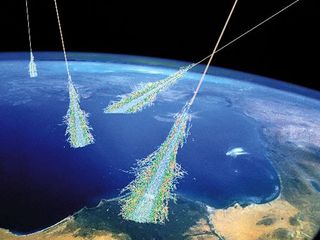what happens to cosmic ray when it hits the atmosphere
What Are Catholic Rays?

Cosmic rays are atom fragments that rain down on the Earth from outside of the solar system. They blaze at the speed of calorie-free and take been blamed for electronics problems in satellites and other machinery.
Discovered in 1912, many things about cosmic rays remain a mystery more than than a century later. One prime instance is exactly where they are coming from. Nearly scientists suspect their origins are related to supernovas (star explosions), but the challenge is that for many years catholic ray origins appeared uniform to observatories examining the unabridged sky.
A large jump forrard in cosmic ray science came in 2017, when the Pierre Auger Observatory (which is spread over 3,000 square kilometers, or 1,160 square miles, in western Argentina) studied the arrival trajectories of thirty,000 catholic particles. It concluded that there is a difference in how frequently these cosmic rays go far, depending on where you look. While their origins are nevertheless nebulous, knowing where to look is the showtime step in learning where they came from, the researchers said. The results were published in Scientific discipline.
Catholic rays tin even exist used for applications outside of astronomy. In November 2017, a research team discovered a possible void in the Neat Pyramid of Giza, which was built around 2560 B.C., using cosmic rays. The researchers establish this cavity using muon tomography, which examines catholic rays and their penetrations through solid objects.
History
While cosmic rays were simply discovered in the 1900s, scientists knew something mysterious was going on as early as the 1780s. That's when French physicist Charles-Augustin de Coulomb — best known for having a unit of electrical accuse named after him — observed an electrically charged sphere all of a sudden and mysteriously not being charged any more.
At the time, air was thought to be an insulator and not an electric conductor. With more work, however, scientists discovered that air can conduct electricity if its molecules are charged or ionized. This would most unremarkably happen when the molecules interact with charged particles or X-rays.
Just where these charged particles came from was a mystery; even attempts to block the charge with big amounts of lead were coming upwardly empty. On Aug. seven, 1912, physicist Victor Hess flew a high-altitude balloon to 17,400 feet (five,300 meters). He discovered three times more ionizing radiation in that location than on the ground, which meant the radiation had to be coming from outer infinite.
But tracing catholic ray "origin stories" took more than a century. In 2013, NASA'due south Fermi Gamma-ray Infinite Telescope released results from observing two supernova remnants in the Milky Way: IC 433 and W44.
Among the products of these star explosions are gamma-ray photons, which (unlike cosmic rays) are non affected by magnetic fields. The gamma-rays studied had the aforementioned energy signature every bit subatomic particles chosen neutral pions. Pions are produced when protons get stuck in a magnetic field inside the shockwave of the supernova and crash into each other.
In other words, the matching free energy signatures showed that protons could move at fast enough speeds inside supernovas to create cosmic rays.
Current scientific discipline
We know today that galactic cosmic rays are atom fragments such as protons (positively charged particles), electrons (negatively charged particles) and diminutive nuclei. While nosotros know now they can be created in supernovas, at that place may be other sources available for cosmic ray creation. It also isn't clear exactly how supernovas are able to make these cosmic rays and then fast.
Catholic rays constantly rain downwardly on Earth, and while the high-free energy "primary" rays collide with atoms in the World'southward upper atmosphere and rarely arrive through to the ground, "secondary" particles are ejected from this standoff and exercise reach the states on the ground.
But by the fourth dimension these cosmic rays get to World, information technology'south impossible to trace where they came from. That's because their path has been changed as they travelled through multiple magnetic fields (the galaxy's, the solar system's and Globe'due south itself.)
Scientists are trying to trace back cosmic ray origins past looking at what the cosmic rays are made of. Scientists can figure this out by looking at the spectroscopic signature each nucleus gives off in radiations, and also by weighing the dissimilar isotopes (types) of elements that hit cosmic ray detectors.
The issue, NASA adds, shows very mutual elements in the universe. Roughly 90 per centum of cosmic ray nuclei are hydrogen (protons) and nine percent are helium (alpha particles). Hydrogen and helium are the near abundant elements in the universe and the origin indicate for stars, galaxies and other large structures. The remaining one percent are all elements, and it's from that 1 per centum that scientists can best search for rare elements to brand comparisons between different types of cosmic rays. The Pierre Auger Observatory collaboration establish some variations in the arrival trajectories of cosmic rays in 2017, providing some hints about where the rays could have originated.
Scientists can also engagement the cosmic rays by looking at radioactive nuclei that decrease over time. Measuring the half-life of each nuclei gives an estimate of how long the cosmic ray has been out there in space.
In 2016, a NASA spacecraft plant almost cosmic rays likely come from (relatively) nearby clusters of massive stars. The agency's Advanced Composition Explorer (ACE) spacecraft detected cosmic rays with a radioactive form of fe known as fe-60. Since this form of cosmic ray degrades over time, scientists judge it must have originated no more than 3,000 lite-years from World — the equivalent distance of the width of the local spiral arm in the Milky Way.
An experiment called ISS-CREAM (Catholic Ray Energetics and Mass) launched to the International Space Station in 2017. It is expected to operate for three years, answering questions such every bit whether supernovas generate virtually cosmic ray particles, when cosmic ray particles originated, and if all the energy spectra seen for cosmic rays tin exist explained by a single mechanism. The ISS also hosts the CALorimetric Electron Telescope (CALET), which searches for the highest-energy types of catholic rays. CALET launched at that place in 2015.
Cosmic rays tin can also be detected past balloon, such as through the Super Trans-Iron Galactic Chemical element Recorder (SuperTIGER) experiment that includes participation from NASA'southward Jet Propulsion Laboratory and several universities. It has flown several times, including a record 55-day flying over Antarctica between December 2012 and January 2013. "With the information from this flight we are studying the origin of cosmic rays. Specifically, testing the emerging model of catholic-ray origins in OB associations, likewise equally models for determining which particles volition be accelerated," the SuperTIGER website said.
Citizen scientists tin can also participate in the search for cosmic rays by registering at the website crayfis.io. At that place, they will join the CRAYFIS experiment run by the Laboratory of Methods for Big Information Analysis (LAMBDA) at the National Research University College School of Economics in Russia. Researchers there are examining ultra-loftier energy cosmic rays using mobile phones.
Space radiation concerns
World's magnetic field and atmosphere shields the planet from 99.nine percentage of the radiation from space. Even so, for people outside the protection of World'south magnetic field, infinite radiation becomes a serious hazard. An instrument aboard the Curiosity Mars rover during its 253-day cruise to Mars revealed that the radiations dose received by an astronaut on even the shortest Earth-Mars round trip would exist about 0.66 sievert. This amount is like receiving a whole-trunk CT scan every v or six days.
A dose of 1 sievert is associated with a 5.v percent increment in the risk of fatal cancers. The normal daily radiations dose received by the average person living on Globe is ten microsieverts (0.00001 sievert).
The moon has no temper and a very weak magnetic field. Astronauts living there would have to provide their own protection, for instance by burying their habitat hush-hush.
Mars has no global magnetic field. Particles from the sun have stripped away most of Mars' atmosphere, resulting in very poor protection confronting radiation at the surface. The highest air pressure level on Mars is equal to an altitude of 22 miles (35 kilometers) above the Globe's surface. At low altitudes, Mars' atmosphere provides slightly better protection from space radiation.
In 2017, NASA made some upgrades to its Space Radiation Laboratory (located at the Brookhaven National Laboratory in New York) to exercise more studies into how cosmic rays may bear upon astronauts on long voyages, including to Mars. These upgrades allow researchers to change types of ions, and the intensity of energy, more than easily due to software control.
Bring together our Infinite Forums to keep talking space on the latest missions, night sky and more! And if you have a news tip, correction or comment, allow us know at: community@space.com.
harrisprityruccon.blogspot.com
Source: https://www.space.com/32644-cosmic-rays.html

0 Response to "what happens to cosmic ray when it hits the atmosphere"
Post a Comment